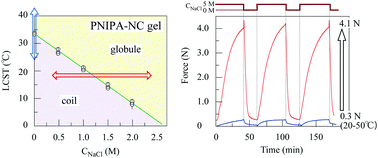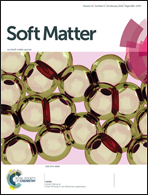Reversible generation of large retractive tensile forces in isometric chemo-mechanical actuators composed of nanocomposite hydrogels and aqueous NaCl solutions†
Abstract
This article addresses the generation of large mechanical forces in muscle-like isometric actuator systems composed of stimuli-responsive nanocomposite hydrogels (NC gels) and aqueous NaCl solutions. NC gels with poly(N-isopropylacrylamide)–clay (PNIPA–clay) network structures exhibit high mechanical toughnesses and reversible swelling/deswelling behavior in the absence/presence of NaCl. NC gels constrained to constant lengths in brine generate enhanced contractive forces due to the salt-induced coil-to-globule transitions that are more than ten times larger than those induced thermally. A retractive tensile force (4 N/170 kPa), comparable to that of human muscle, was repeatedly generated at 20 °C using an appropriately composed NC gel (clay: 2 mol%, PNIPA: 2 M), and by alternating the NaCl concentration between 0 and 5 M. This phenomenon is attributed to the combined effects of enhanced deswelling behavior resulting from the salt-induced coil-to-globule transition of PNIPA and the high stiffness of the deswollen gel due to the NaCl-strengthened PNIPA–clay network.



 Please wait while we load your content...
Please wait while we load your content...